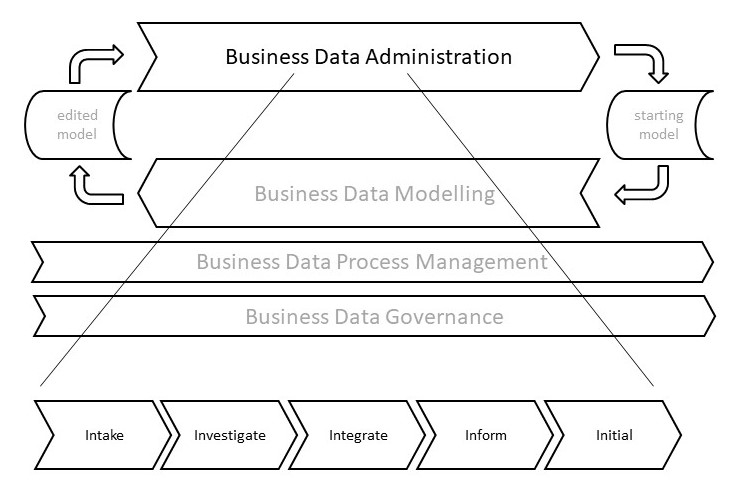Business Data Administration
Business Data Administration - the steps
Within Business Data Management we also have a need to use an accounting system in order to document and control the descriptive model. Basis is the lexicon and after execution of the modelling function, the Business Data Model in full. The meta data of the Business will be the data for the Business Data Administration function.
Business Data Administration will be the guardian of the Business Data Model of the company. It may include the following steps:
Intake – Investigate – Integrate – Inform – Initial
At both ends of this process we see the Intake and Initial functions. Business Data Administration will be the starting point for improvement or extension of a Business Data Model.


When a definition or modelling team is done with their work or part of their work, they bring back the results to Business Data Administration, to the Intake function. Intake will check if the right procedures and guidelines were followed. The procedures in terms of the right Initial models used, validation by business owners, modelling guidelines followed, the right tools used, etc. The check will mainly be on the appearance of the presented models. If the model(s) do not comply to the standards, it will not be accepted by Intake. The development team in question will be informed about the nonconformity aspects identified. The development team will have to re-deliver the models, according to the standards. Business Data Models that apply to the procedures and guidelines will be transferred to the second line of approval: the Investigate function.

The Investigate function will review the Business content delivered by a team. Although the results are accepted by the Business owners, inconsistency’s within and between models may easily occur due to different viewpoints or business boundaries. The results will be checked on integrability and on oncoming results of other development teams. The delivering team in question will be invited to discuss the results of the Investigate function and proposed changes discussed. The development team will have to re-deliver the models according to agreed changes. Accepted models are delivered to Integrate.

The Integrate function will add the approved results to the Business Data Model of the company. Updated parts of the models will replace existing or outdated parts and newly created parts will be added to the model. It would be strongly recommended that in time, evolved versions of the several parts of the Business Data Model will be kept for information and fall-back purposes for a certain period of time. At the same time, models developed for future situations to become actual after a certain moment of transition, will be integrated on a future basis and transitions will be monitored for actual implementation.

The Inform function will the window of Business Data Administration for any questions about the Business Data Model. It will communicate new results integrated to the Business Data Model to different stakeholders. That will the owners but may also be Business Process Managers, regular data management or the IT department. It will also communicate the changes to the development teams that have previous versions of any of the changed parts of the Business Data Model in development themselves.

The Initial function will provide a (definition or modelling) team a starting model which will be based on the latest accepted version. It may be the full model of a single Business within the organisation or only parts of it which are under attention of the team. Within Business Data Administration these parts will be marked as “under development” and by whom. If parts of this starting model is already marked as “under development”, all developing teams will be informed about the new initiative and delivered starting model.
How to organise Business Data Administration
In general, Data Administration will be centrally organized within an organization for the following reasons:
- To concentrate the expert knowledge on Business Data Administration and Business Data Modelling.
- To create a minimum of critical employees for the company.
- To prevent overlap in generic data models, used in multiple business domains and to prevent versioning and synchronization problems.
Disadvantage of the centralized function is that the Data Administration function may be less close to the different Businesses (Business owners).
In a mature and data minded organisation a decentralized Data Administration function may be considered. The function may be executed from the business domains if:
- There is no or hardly any overlap in business terms between the Businesses, or
- If the decentralised functions are supported by a centralized data administration accounting system (and tool) and special attention is given to functional alignment across the business lines.